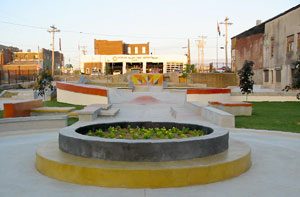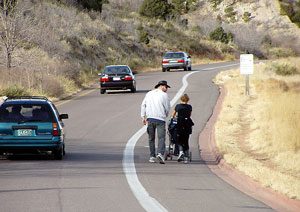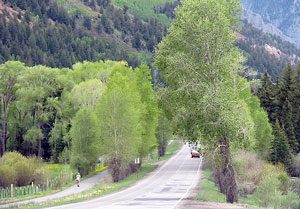Jul 27, 2016
Building Rural Environments for Active Living
Today is the day you finally decide to strap on those running shoes and kick the healthy habits into overdrive. You begin to jog but soon realize there aren't sidewalks or safe paths outside of traffic. Or perhaps you hope to ride your bike but find that the roads are too narrow to share. Maybe you're a kid who has never enjoyed traditional activities such as basketball or football, but you have no other options for activities. Feeling defeated, you put off today's exercise thanks to an environment unfit for fitness.
Where we live influences how well we live. You might say that our zip code can be more important than our genetic code.
"Where we live influences how well we live," stated Katie Wehr, Program Officer with the Robert Wood Johnson Foundation (RWJF). "You might say that our zip code can be more important than our genetic code."
For roughly six years, Wehr has worked with the RWJF to promote and create cultures of health in communities across the country. She states in her professional biography (no longer available online) that "It takes all of us to improve the quality of people's lives, prevent illness, and make our communities vibrant, healthy places—no matter where people live, learn, work and play."
According to Wehr, nearly one in five rural counties are experiencing worsening premature death rates in the past decade. In addition, rural children and adults have significantly higher rates of obesity than their urban counterparts. No single factor is responsible for the significant differences in health between rural and other types of counties, but evidence suggests that differences in environment play a role.
Research from the University of Illinois found that just 20 minutes in nature can promote health and well-being. There's an assumption that rural areas provide ample opportunities for recreation in nature. However, researchers noted that many rural, low-income residents (in this particular study, rural mothers) who rely on outdoor activities to improve health and well-being for themselves and their families face obstacles in accessing publicly available outdoor recreation resources.
"You might live in rural Illinois, surrounded by cornfields, all of which are privately owned. You could walk down a county road or a highway, but unless there was community investment in a park or a playground, a walking trail, or some kind of a facility at a local school, moms didn't have access to nature, even though they were surrounded by it," stated study co-author Ramona Oswald in a press release (no longer available online).
Human-made social environments or "built environments" have an extraordinary impact on our health. Our surroundings shape the availability of safe places to play, of high-quality schools, of available jobs, of clean air and water, and of fresh foods and vegetables. Environments also shape our activities and how we move.
Lacking infrastructure in rural areas is a common barrier to physical activity. Safety fears such as high traffic speeds, the threat of wild animals or loose dogs, and insufficient lighting and sidewalks are all too familiar for rural towns. The feasibility of active transportation, such as walking or biking, is also limited by dispersed rural and remote areas where residents live far from schools, worksites, and other common destinations.
These challenges are compounded in rural communities due to insufficient tax bases and shifting demographics.
"These challenges are compounded in rural communities due to insufficient tax bases and shifting demographics," said Wehr. "There's a limited understanding of approaches that are working in rural areas."
A Lesson in Innovation
Innovation is key in addressing the active needs of young and old, rich and poor. New walkways, greeneries, and facilities can add a sense of community and visual appeal for towns. In Poplar Bluff, Missouri, a skate plaza added an artistic zeal to its downtown space.
"I think the area is appreciated by spectators and skaters alike," observed Clark Allen, Director of the Poplar Bluff Parks and Recreation Department.

In July 2012, Poplar Bluff Parks and Rec broke ground on the plaza project after 10 years in the making. The idea came about from local skateboarders urging the department to provide a safe and legal place to skate. Allen stated that many skateboarders are kids who don't find organized, traditional sports appealing, and that innovation is needed in communities to get this particular population moving.
"These kids finally have somewhere to go," said Allen. "There's a saying among skateboarders, 'If your city doesn't have a skate park, your city is the skate park.'"
Downtown Poplar Bluff is home to more businesses than residential housing, so there are few issues with noise complaints. Live bands and skateboarding-related events held at the plaza have helped bring life to the community.
"They used to mainly skate on private property. Businesses are happy and the kids are too," explained Allen. "With [increasing] type 2 diabetes and obesity, you see a growing motivation and number of grant programs for young people."
Slightly over half of the $450,000 price tag was covered by a Healthy and Active Communities grant from the Missouri Foundation for Health (MFH). The grant initiative focused on addressing childhood obesity and activity in the Show Me State. The MFH category that Allen and his team sought was "innovative funding." Up until that time, MFH had never helped build a skate park or plaza.
The 19,000 square foot plaza blends nicely into the feel of the downtown scene. Located on site are additional green spaces for pedestrians to enjoy, and the plaza color coordinates with local historical sites. The Fire Department is located right across the street, which adds an element of safety and community. Allen notes the location is perfect for promoting an active community.
Some communities build their skate parks away from town, too far of distances for the average kid to get to. This location was definitely a bonus. Where there was essentially nothing, we've built something great for our town.
"Some communities build their skate parks away from town, too far of distances for the average kid to get to. This location was definitely a bonus," stated Allen. "Where there was essentially nothing, we've built something great for our town."
What Your Community Can Do
Before breaking ground on new walk paths or bike lanes, communities will need to assess their existing built environments. Understanding infrastructure features will help leaders accomplish particular health initiatives requiring built projects. The Centers for Disease Control and Prevention offers an extensive Built Environment Assessment Tool (BE Tool) to measure the core features and qualities of the built environment that affect health, especially walking, biking, and other types of physical activity.

Like the Poplar Bluff plaza, building infrastructure to intertwine with the town's existing space will garnish more support for projects. Connecting walkways and bike paths to common destinations such as the grocery store or schools encourages active transportation, especially for people without reliable transportation. According to Smart Growth America, 1.6 million rural households don't have access to a car.
Expanding existing roads to create room for biking and walking goes a long way. However, "Complete Streets" should not be thought of as a one-size-fits-all solution. For example, as detailed by The National Complete Streets Coalition (fact sheet no longer available online), roads surrounded by agricultural use may be complete by simply providing wide shoulders to allow safe bicycling and walking and providing connections to regional trail and public transportation networks.

On roads where homes and other destinations are concentrated along one side of the street, sidewalks lining just that side may best fit the community context. In town centers, narrower streets, well-marked pedestrian crossings, sidewalks, and street trees can all work to improve safety while maintaining a pleasant, small-town feel.
As Katie Wehr mentioned earlier, a restricted tax base could limit rural options for wellness in built environments. However, it's important to work with city and county officials to make sure active spaces are thought about when it comes to new developments. Health in All Policies is a useful framework for local communities to ensure that population health is considered in decision-making across all sectors, including the construction of the built environment. For communities that seek to improve their environment with new infrastructure, County Health Rankings & Roadmaps offers numerous "master plans" and mixed-use development resources to organize initiatives. There are always grants out there if you know where to look; we host a database of them at the Rural Health Information Hub.
You can see more examples of successful built environment projects in our Models and Innovation section.
